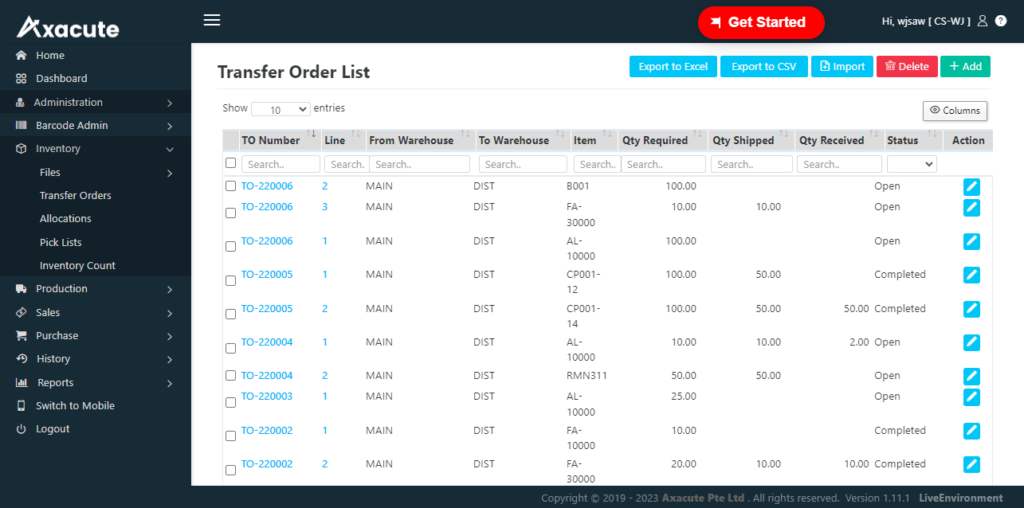
Warehouse operations are crucial for ensuring a seamless supply chain management process. Within these operations, the concept of transfer orders plays a pivotal role, facilitating the movement of inventory from one location to another.
From the generation of transfer orders to the challenges and solutions associated with their execution, understanding the intricacies of this process is fundamental for warehouse efficiency
A transfer order in a warehouse is a comprehensive document that authorizes the movement of inventory from one location to another within the same warehouse or between different warehouses.
It serves as a directive that outlines the specifics of the transfer, including the items to be moved, the quantity, the source, and the destination locations, among other essential details.
Efficient transfer orders are essential for maintaining an organized and optimized warehouse system. They ensure that the right products are in the right place at the right time, thereby preventing delays in fulfilling orders and reducing the risk of stockouts.
The process of generating transfer orders typically involves assessing inventory levels, identifying the need for relocation, and initiating the necessary documentation. Automation through Warehouse Management Systems (WMS) has significantly streamlined this process, enhancing efficiency and accuracy.
Transfer orders encompass vital information, such as the SKU (Stock Keeping Unit) details, quantities to be transferred, source and destination locations, and any special handling instructions. Additionally, timestamps and responsible personnel are often included to ensure accountability.
Implement a systematic approach to inventory management, including well-defined storage locations, clear labeling, and periodic audits. This helps in ensuring that inventory is accurately tracked and easily accessible when transfer orders are initiated.
Integrate advanced Warehouse Management Systems (WMS) and inventory tracking tools. These systems enable real-time monitoring of inventory movement, reducing the likelihood of errors and delays during the transfer process.
Establish clear communication channels and protocols within the warehouse. Regular team meetings, digital communication tools, and well-defined standard operating procedures can significantly streamline the transfer process, minimizing errors and ensuring timely execution.
Provide comprehensive training to warehouse staff on the use of transfer order systems and technologies. This equips them with the necessary skills to handle transfer orders efficiently and reduces the likelihood of errors due to lack of understanding.
Conduct regular audits to ensure that transfer orders are being executed accurately and in a timely manner. Periodic reviews help in identifying any potential issues or bottlenecks in the transfer process, allowing for timely corrective actions.
Leverage data from the transfer order process to make informed decisions regarding inventory management and warehouse operations. Analyzing data trends and patterns can help in identifying areas for improvement and optimizing the overall transfer order process.
Foster strong relationships with suppliers and logistics partners. Open lines of communication and collaboration can ensure a smoother transfer process, from the initiation of transfer orders to the final delivery of goods.
Discrepancies in inventory records between the actual physical count and the digital data can lead to confusion during the transfer process, resulting in incorrect shipments or delayed transfers.
Inadequate communication among warehouse staff, particularly regarding transfer details and timelines, can create confusion and disrupt the transfer process, leading to inefficiencies and potential errors.
Implement advanced inventory management systems that provide real-time updates on inventory levels. This helps in minimizing discrepancies and ensures accurate execution of transfer orders, reducing errors and delays.
Axacute is a software that provides real-time visibility into your shop floor and warehouse operations which includes feature to ensure accurate transfer orders.

Establish clear communication channels and protocols within the warehouse. Regular team meetings, the use of digital communication tools, and well-defined standard operating procedures can help in streamlining the transfer process, minimizing confusion, and improving overall efficiency.
Encourage collaboration between different departments involved in the transfer order process. This can help in fostering a better understanding of the entire workflow, leading to improved coordination and smoother execution of transfer orders.
Provide regular training sessions for warehouse staff to enhance their understanding of transfer order procedures and technologies. This can significantly reduce errors and ensure that staff members are well-equipped to handle any challenges that may arise during the transfer process.
Continuously evaluate the transfer order process to identify any inefficiencies or bottlenecks. Implementing periodic reviews and assessments can help in identifying areas for improvement and implementing necessary changes to streamline the transfer process.
Explore opportunities for automation within the transfer order process. Implementing automated systems for order processing, inventory tracking, and data management can significantly improve accuracy, reduce manual errors, and expedite the overall transfer process.
In conclusion, the smooth execution of transfer orders is vital for maintaining an organized and efficient warehouse system. By embracing technological advancements and implementing effective communication strategies, warehouses can streamline their operations and meet the demands of a dynamic supply chain landscape.
Contact Us
Related
Related
Get started with Axacute and improve your business operations.